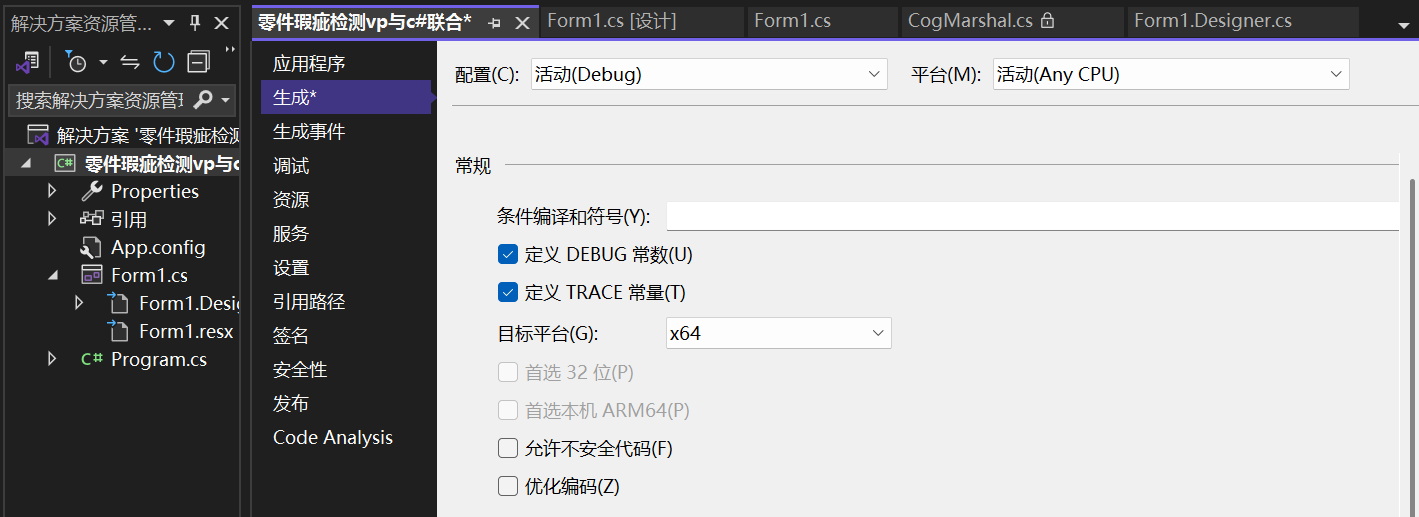思路:
1.在visionpro中将视觉部分处理完毕实现该有的效果(我这里案例是零件的瑕疵检测)
2.导出ToolBlock
3.在winform通过c#代码实现UI
一.VisonPro的ToolBlock导出
1.vp中瑕疵检测的功能实现


检测四个圆是否有瑕疵

检测顶头是否有瑕疵
#region namespace imports
using System;
using System.Collections;
using System.Drawing;
using System.IO;
using System.Windows.Forms;
using Cognex.VisionPro;
using Cognex.VisionPro.ToolBlock;
using Cognex.VisionPro3D;
using Cognex.VisionPro.PMAlign;
using Cognex.VisionPro.CalibFix;
using Cognex.VisionPro.Blob;
using Cognex.VisionPro.ImageProcessing;
#endregion
public class CogToolBlockAdvancedScript : CogToolBlockAdvancedScriptBase
{
#region Private Member Variables
private Cognex.VisionPro.ToolBlock.CogToolBlock mToolBlock;
CogGraphicLabel myLabel = new CogGraphicLabel();
#endregion
/// <summary>
/// Called when the parent tool is run.
/// Add code here to customize or replace the normal run behavior.
/// </summary>
/// <param name="message">Sets the Message in the tool's RunStatus.</param>
/// <param name="result">Sets the Result in the tool's RunStatus</param>
/// <returns>True if the tool should run normally,
/// False if GroupRun customizes run behavior</returns>
public override bool GroupRun(ref string message, ref CogToolResultConstants result)
{
// To let the execution stop in this script when a debugger is attached, uncomment the following lines.
// #if DEBUG
// if (System.Diagnostics.Debugger.IsAttached) System.Diagnostics.Debugger.Break();
// #endif
// Run each tool using the RunTool function
foreach(ICogTool tool in mToolBlock.Tools)
mToolBlock.RunTool(tool, ref message, ref result);
CogBlobTool c = mToolBlock.Tools["CogBlobTool1"] as CogBlobTool;
CogHistogramTool c1 = mToolBlock.Tools["CogHistogramTool1"] as CogHistogramTool;
string a;
if(c.Results.GetBlobs().Count == 4 && c1.Result.Mean > 100)
{
a ="OK";
}
else
{
a = "NG";
}
mToolBlock.Outputs["res"].Value = a;
//为label设置上卡尺的信息
myLabel.SetXYText(150, 50,"检测结果:"+a);
myLabel.Color = CogColorConstants.Red;
myLabel.Font = new Font("楷体:", 18);
return false;
}
#region When the Current Run Record is Created
/// <summary>
/// Called when the current record may have changed and is being reconstructed
/// </summary>
/// <param name="currentRecord">
/// The new currentRecord is available to be initialized or customized.</param>
public override void ModifyCurrentRunRecord(Cognex.VisionPro.ICogRecord currentRecord)
{
}
#endregion
#region When the Last Run Record is Created
/// <summary>
/// Called when the last run record may have changed and is being reconstructed
/// </summary>
/// <param name="lastRecord">
/// The new last run record is available to be initialized or customized.</param>
public override void ModifyLastRunRecord(Cognex.VisionPro.ICogRecord lastRecord)
{
//一代表要渲染的图型,二代表运行记录,表示这次渲染接着上一次渲染的结果继续
//三代表显示的位置,四代表此次操作的标记,可以为空
mToolBlock.AddGraphicToRunRecord(myLabel, lastRecord, "CogPMAlignTool1.InputImage", "");
}
#endregion
#region When the Script is Initialized
/// <summary>
/// Perform any initialization required by your script here
/// </summary>
/// <param name="host">The host tool</param>
public override void Initialize(Cognex.VisionPro.ToolGroup.CogToolGroup host)
{
// DO NOT REMOVE - Call the base class implementation first - DO NOT REMOVE
base.Initialize(host);
// Store a local copy of the script host
this.mToolBlock = ((Cognex.VisionPro.ToolBlock.CogToolBlock)(host));
}
#endregion
}
通过ToolBlock中的c#高级脚本将OK和NG进行区分然后将值传入到output中,方便我们后续在winfrom中获取到ok和ng数据
2.将ToolBlock导出

通过图上步骤将ToolBlock保存下来
注意:文件后缀要是.vpp格式!!!!!!!别保存错了,错了会调用失败!
二.进入Visual Studio
1.创建窗体应用

这里也要注意创建的是.NET Framework的窗体应用
2.配置编程环境
(1).
将目标平台改为x64
(2).


然后将图一内的文件拖入我们添加的选项卡中
注意:尽量将文件夹靠近工具箱拖入可任意更容易成功;
这里面就是vp为我们提供的控件
(3).
将我们保存的ToolBlock的vpp文件和图像资源放入我们的DeBug目录下方便我们们后面路径的描述

3.Winfrom界面的布局

思路:1.先将图片读取到cogRecordDisplay1中
2.然后将读取到的图片传给CogToolBlockEditV21进行检测获取到检测结果
3.创建OK和NG文件夹将OK和NG图像分别存入两个文件夹中
4.c#代码的实现
(1).引入我们需要的命名空间
using Cognex.VisionPro;
using Cognex.VisionPro.ToolBlock;
using Cognex.VisionPro.ImageFile;(2).创建ToolBlock和将图像加载实例
CogToolBlock mToolblock;
CogImageFileTool fileTool = new CogImageFileTool();(3).加载vpp文件到CogToolBlockEditV21控件中
private void Form1_Load(object sender, EventArgs e)
{
try
{
string path = Directory.GetCurrentDirectory() + "\\零件瑕疵检测(ToolBlock).vpp";
mToolblock = new CogToolBlock();
mToolblock = (CogToolBlock)CogSerializer.LoadObjectFromFile(path);
MessageBox.Show("加载vpp成功!");
cogToolBlockEditV21.Subject = mToolblock;
}
catch(Exception ex)
{
MessageBox.Show(ex.Message);
}
}(4).将图像名按数字排序方便遍历读取,点击按钮button1后读取图像到cogRecordDisplay1并启动CogToolBlockEditV21进行检测输出检测结果
private void button1_Click(object sender, EventArgs e)
{
//读取照片
string path =$"C:\\Users\\14350\\Desktop\\SHIJUE\\联合编程vp与c#\\零件瑕疵检测vp与c#联合\\零件瑕疵检测vp与c#联合\\bin\\Debug\\img\\{i}.bmp";
fileTool.Operator.Open(path, CogImageFileModeConstants.Read);
fileTool.Run();
cogRecordDisplay1.Image= fileTool.OutputImage;
i++;
if (i == 11)
{
i = 1;
}
mToolblock.Inputs["OutputImage"].Value = cogRecordDisplay1.Image;
mToolblock.Run();
SaveImage();
}(5).封装SeveImage方法保存检测后的图像
private void SaveImage()
{
//获取到检测结果
string result =mToolblock.Outputs["res"].Value.ToString();
if (result == "OK")
{
string path = Directory.GetCurrentDirectory() + @"\OK";
string fileName = $"OK\\{DateTime.Now.ToString("HHmmss")}.bmp";
if (!Directory.Exists(path))
{
Directory.CreateDirectory(path);
}
fileTool.InputImage = cogRecordDisplay1.Image;
fileTool.Operator.Open(fileName, CogImageFileModeConstants.Write);
fileTool.Run();
}
else
{
string path = Directory.GetCurrentDirectory() + @"\NG";
string fileName = $"NG\\{DateTime.Now.ToString("HHmmss")}.bmp";
if (!Directory.Exists(path))
{
Directory.CreateDirectory(path);
}
fileTool.InputImage = cogRecordDisplay1.Image;
fileTool.Operator.Open(fileName, CogImageFileModeConstants.Write);
fileTool.Run();
}
}三.c#的源代码
using System;
using System.Collections.Generic;
using System.ComponentModel;
using System.Data;
using System.Drawing;
using System.IO;
using System.Linq;
using System.Text;
using System.Threading.Tasks;
using System.Windows.Forms;
using Cognex.VisionPro;
using Cognex.VisionPro.ToolBlock;
using Cognex.VisionPro.ImageFile;
namespace 零件瑕疵检测vp与c_联合
{
public partial class Form1 : Form
{
public Form1()
{
InitializeComponent();
}
CogToolBlock mToolblock;
CogImageFileTool fileTool = new CogImageFileTool();
private void Form1_Load(object sender, EventArgs e)
{
try
{
string path = Directory.GetCurrentDirectory() + "\\零件瑕疵检测(ToolBlock).vpp";
mToolblock = new CogToolBlock();
mToolblock = (CogToolBlock)CogSerializer.LoadObjectFromFile(path);
MessageBox.Show("加载vpp成功!");
cogToolBlockEditV21.Subject = mToolblock;
}
catch(Exception ex)
{
MessageBox.Show(ex.Message);
}
}
private void cogDisplay1_Enter(object sender, EventArgs e)
{
}
int i = 1;
private void button1_Click(object sender, EventArgs e)
{
//读取照片
string path =$"C:\\Users\\14350\\Desktop\\SHIJUE\\联合编程vp与c#\\零件瑕疵检测vp与c#联合\\零件瑕疵检测vp与c#联合\\bin\\Debug\\img\\{i}.bmp";
fileTool.Operator.Open(path, CogImageFileModeConstants.Read);
fileTool.Run();
cogRecordDisplay1.Image= fileTool.OutputImage;
i++;
if (i == 11)
{
i = 1;
}
mToolblock.Inputs["OutputImage"].Value = cogRecordDisplay1.Image;
mToolblock.Run();
SaveImage();
}
private void SaveImage()
{
//获取到检测结果
string result =mToolblock.Outputs["res"].Value.ToString();
if (result == "OK")
{
string path = Directory.GetCurrentDirectory() + @"\OK";
string fileName = $"OK\\{DateTime.Now.ToString("HHmmss")}.bmp";
if (!Directory.Exists(path))
{
Directory.CreateDirectory(path);
}
fileTool.InputImage = cogRecordDisplay1.Image;
fileTool.Operator.Open(fileName, CogImageFileModeConstants.Write);
fileTool.Run();
}
else
{
string path = Directory.GetCurrentDirectory() + @"\NG";
string fileName = $"NG\\{DateTime.Now.ToString("HHmmss")}.bmp";
if (!Directory.Exists(path))
{
Directory.CreateDirectory(path);
}
fileTool.InputImage = cogRecordDisplay1.Image;
fileTool.Operator.Open(fileName, CogImageFileModeConstants.Write);
fileTool.Run();
}
}
}
}
四.总结
vp与c#的联合编程主要在vp中将功能实现,然后在winform中获取到检测的结果实现窗体的布局实现交互。
























 499
499

 被折叠的 条评论
为什么被折叠?
被折叠的 条评论
为什么被折叠?








